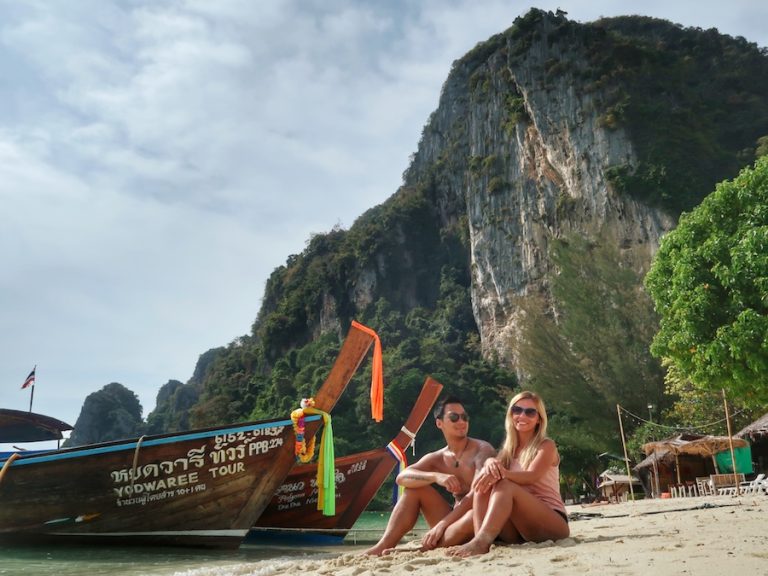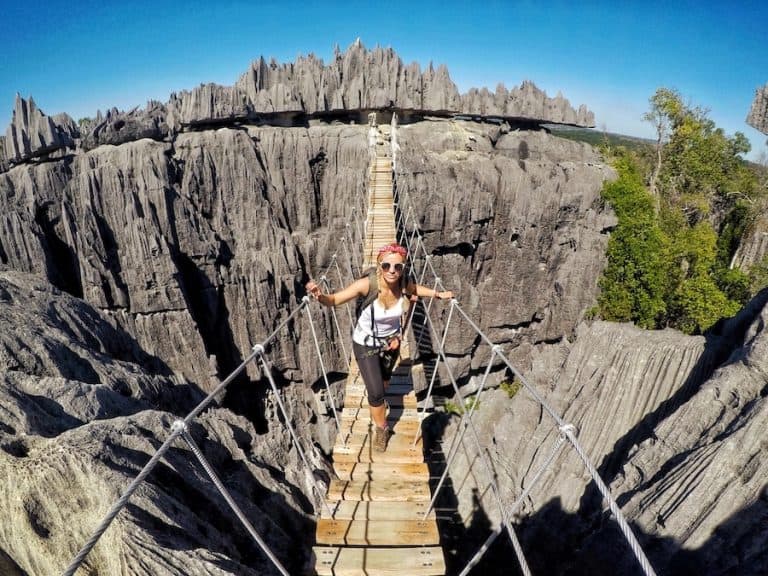Trekking In Sapa, Vietnam | A Beginner’s Guide

The non-stop hustle and bustle of Vietnamese cities can be a little overwhelming at times. So when we arrived in Northern Vietnam, we thought it was time for something a little more scenic. Without a second thought, we were on our way to do some trekking in Sapa.
Sapa has some of the most beautiful landscapes in Vietnam. This small town is surrounded by layers of rice terraces and intimidating mountains including Mount Fansipan – Vietnam’s tallest peak.
Sapa is also home to several ethnic minorities like the Hmong and Dao. The chance to see them go about their traditional way of life is often a highlight for many people. It’s no wonder that more and more traveller’s are adding Sapa to their Vietnam itineraries!
How To Get To Sapa

Sapa town, located in the far Northwest of Vietnam, is small and remote. Travel an hour further north and you’ve reached the Chinese border! Any journey to Sapa would have to start in Hanoi, and you can normally arrange transport with your hotel or any Hanoi travel agent.
Overnight Sleeper Train To Lau Cai
The overnight sleeper train is probably the most comfortable way to get to Sapa. Most of the trains leave around 10:00pm and the journey time is 8 hours. The ride quite long but also comfortable, as long as you don’t mind sharing a cabin with three other passengers.
You can upgrade to a private cabin with power sockets to charge your devices and complimentary snacks. Prices start from around $27 and can go up to $100 depending on cabin size and class. Please not that the arrival station is at Lau Cai and you’ll need to negotiate a shuttle to Sapa town (around 50,000 VND.)
Overnight Bus To Sapa Town
The other option is to take the overnight bus. The journey is only 6 hours and you arrive in Sapa town. The bus will drive through winding mountain roads but this didn’t bother us on our overnight journey. The bus will also stop a couple of times for toilet breaks. We booked a VIP sleeper and it felt like sleeping in a cool space capsule.
Overnight buses set off from Hanoi at 10pm and arrive in Sapa town around 3am-4am but you can sleep on the bus until 6am. Prices range from $12 and can go up to $20 for first class sleepers. There are plenty of day buses too and you can normally book these at a cheaper price.
Best Time To Visit Sapa
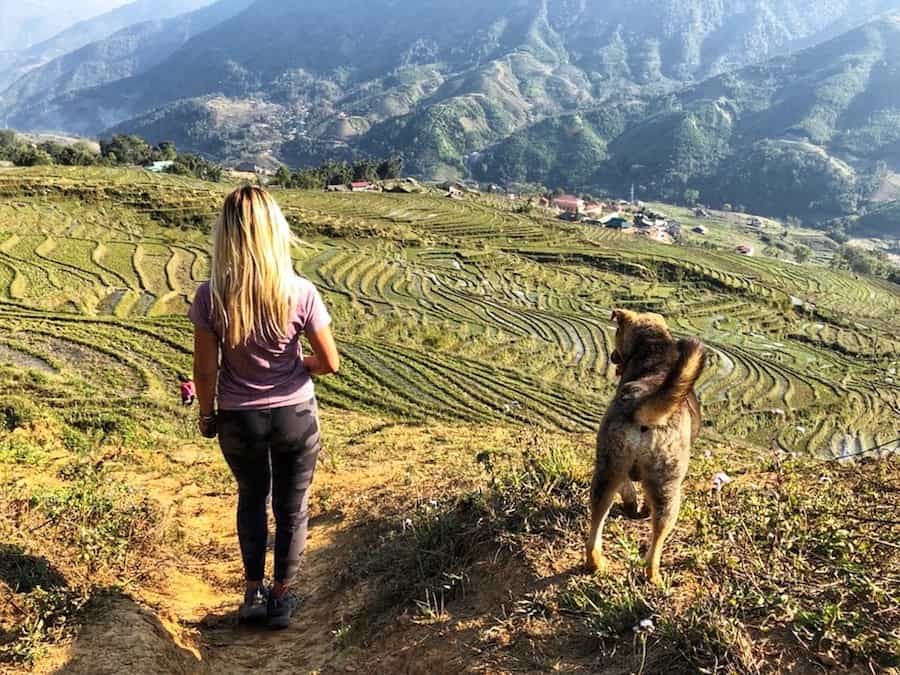
The great thing about Sapa is that it can be visited all year round. It all depends on what you’re looking for. Maybe you prefer warmer weather or maybe you don’t mind a bit of rain. The decision may even be based on how you want to view the famous rice terraces. Here’s a rough month to month guide on what to expect.
Guide To Sapa Weather & Rice Fields
March to May is considered by many to be the best time to go trekking in Sapa. The weather starts to warm up and can be a little humid at times. In April, the farmers start to plant the rice in the terraces.
June to August can see temperatures climb even higher and it’s also the start of rainy season! The rice fields are lush and green so, if you can stand the heat and you don’t mind the occasional downpour, this is a great time to visit (this is also peak season for Vietnamese tourists.)
September to November sees the rains ease off and the temperature cool down. One of the best times to trek in Sapa. September is also the best month to see the rice fields. The farmers will start to harvest the rice in October so this is a great time for photos.
December To February are the coldest months but also the best months to avoid tourists! Trekking is still possible but some days may see the temperature drop below 0°C! The rice fields are now beautiful pools of water. If you’r lucky enough you may see frost, or even snow, covered terraces.
Trekking In Sapa

Trekking in Sapa is definitely one of those activities that make Vietnam a place worth visiting. There are so many options for travellers when it comes to choosing your trek experience. You only have to walk around Hanoi to see signs and agencies offering tours. Whether you book a tour from Hanoi or Sapa, make sure you shop around for the best price and ask plenty of questions: What would you like to see? How many people will be in the group? Will there be rice terraces on the way?
Day Treks In Sapa
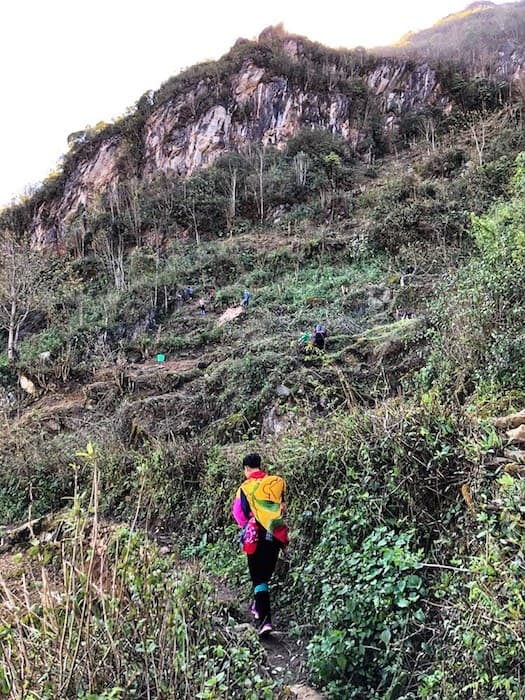

If you’ve decided to wait until you arrive in Sapa town to book your trekking tour then you have plenty of options. Your hotel, or guesthouse, will most likely be well connected with tour agencies and will be more than willing to book a trek for you. That doesn’t mean you can’t shop around for the best deal.
If you arrive by overnight bus you are usually greeted by a local women asking if they can be your guide. Just take their mobile number and ask them for more information when you’re more awake! They’re usually very polite and this can be an excellent way to enjoy a more local experience as you’ll be trekking to their home.
Expect to pay around $20-$30 for a day trek, with a guide, in Sapa.
Overnight Treks With Homestay
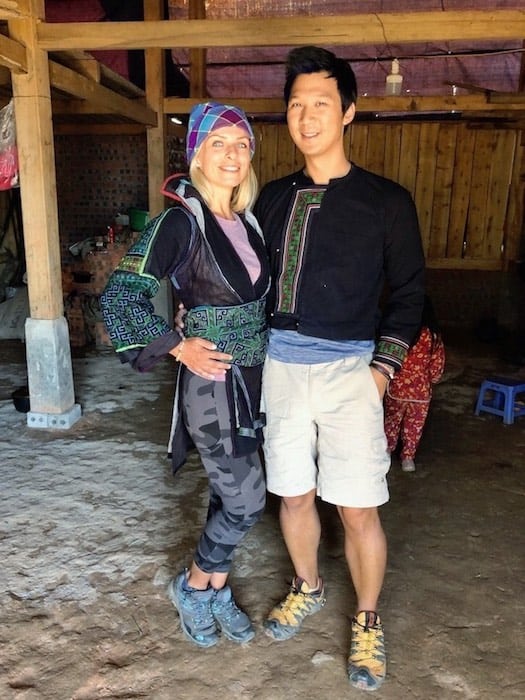

Often one of the highlights for many travellers is the chance for an overnight homestay with a ethnic minority family. After a long day of trekking you will often get a chance to help the family cook dinner, play games with the children and even sample some local rice wine!
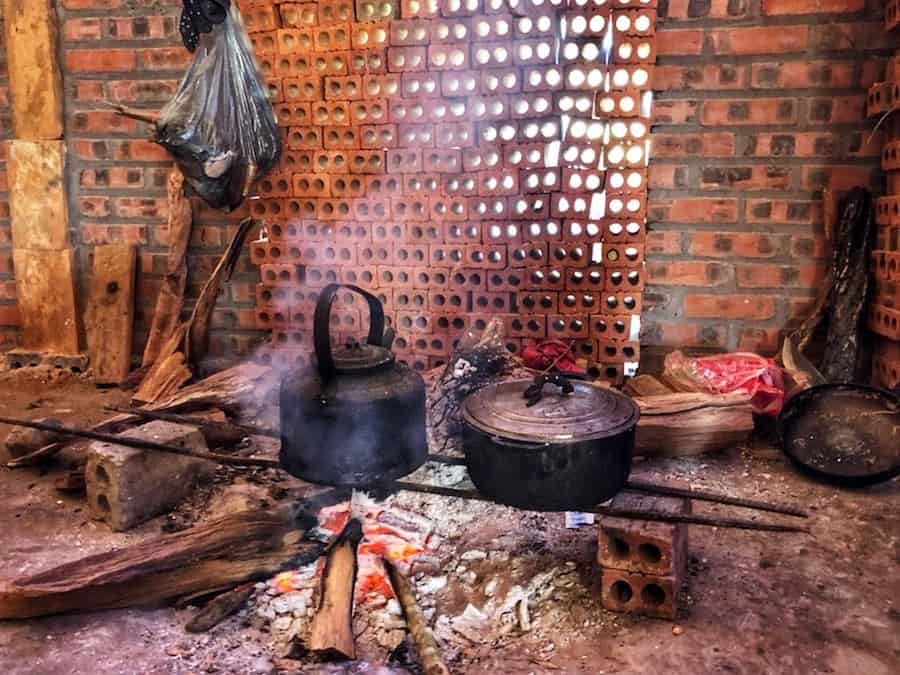
Overnight trekking also means you get to travel further out from town and access the more remote areas of Sapa. The only negative is that these tours are more popular so you may find yourself sharing this experience with more travellers than you’d like.
Sapa Tour From Hanoi
You’ll see many offers for trekking tours to Sapa. Many of the agencies and hotels are selling the same tour but the price will depend on what commission they’re after. They may even lower their asking price if you know how to negotiate.
The standard trekking tours from Hanoi start with an overnight bus or train to Sapa. Arriving around 6am, you will then have breakfast (don’t forget your Vietnamese coffee!) before starting your trek around 8am-9am. Depending on the length of your tour, you will have one or two days of trekking and a homestay experience with a local family. All meals are usually included (trust me, you won’t go hungry!) as is the return transport back to Hanoi.
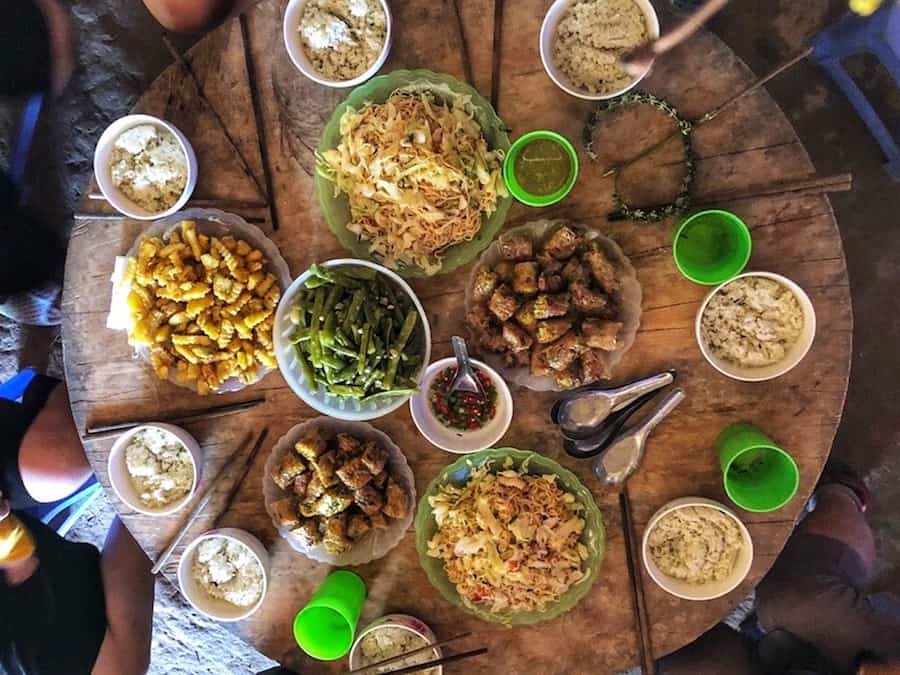
Prices can be as much as $190 per person for a 3 day 2 night trek with an overnight train. This may sound expensive but it includes all meals and everything is taken care of.
Tip | Many tours from Hanoi don’t give you a lot of time to explore Sapa town itself. Be sure to ask the question if this is something you would like to see.
Trekking In Sapa Without A Guide
Trekking in Sapa with a local guide is a great way to learn about the culture of the ethnic minorities. If you prefer to trek independently, or you simply don’t have the budget, it’s possible to trek without a guide.
There are many self-guided trails from Sapa town including the tourist villages of Cat Cat Village and Muong Hoa Valley. The only time you’ll need an experienced guide is if you’re tackling Fansipan Peak.
The good news is that you can still experience an overnight homestay with a local hill tribe family. Although it’s always better to book in advance, you’ll pass through many villages where there are many signs advertising ‘homestays’. Just politely as if there’s availability.
What To Pack For Your Sapa Trek

You’ve booked your trekking trip and you’re now ready to set off. If you’re smart, you’ll pack light but here are a few helpful tips that might make your trek a little easier:
Luggage
You’ll only need your daypack and, depending on which tour you’ve booked, leave your main bag behind. Why would you want to carry a 15-20kg bag up the mountains anyway?
If you’ve booked your Sapa trek from Hanoi, your agency will let you leave your main luggage with them until you return. Treks booked from Sapa can leave their luggage with the tour operator or their hotel.
What To Wear For Your Sapa Trek
- Good hiking shoes – perhaps the most important item! The terrain in and around Sapa can be tough on your feet. You’ll be trekking through fields and streams, up steep hills, over slippery rocks and possibly in muddy or wet conditions.
- Lightweight Jacket – you’ll want a jacket that can easily be folded away into your daypack but also windproof and rainproof if possible. It can be very windy when you walk over those mountain passes.
- Socks – preferably hiking socks. It may sound like a marketing ploy but hiking socks are thicker so you’ll have less chance of blisters. They’re also tougher and made from odour resistant fabrics. Some are even waterproof.
- Poncho – every traveller knows the value of a poncho. Even the cheap ones that you can only use once or twice!
- Hat – if you’re sensitive to the sun then a hat will be your best friend. You’ll also save your neck from being that nasty red colour!
- Flip Flips (Thongs for our friends Down Under!) – small enough to slide into your daypack without taking up too much room. Your feet will love these after spending hours in those hiking shoes!
- Spare Clothes – you may be on a longer trek or you might end up trekking in the rain. Either way a change of clothes will always be useful, even on a day trek.
- Seasonal Clothes – it goes without saying that you’ll need to dress for the weather. The best way to do this is to dress in layers. If you know you’ll be trekking in 30°C heat then you wont’ need much than a t-shirt and a pair of shorts. Trekking in winter? Then layer up to your own comfort level.
- Trekking Poles – these are a personal choice. Some tour operators will provide you with poles. I don’t disagree that they have their uses but I didn’t use them on this occasion.
Personal Items
- Camera/Smartphone – it would be a crime to not be able to look back on this memorable experience. Take plenty of pictures but remember, the best memories will be recorded with you eyes!
- Power Bank/Spare Batteries – you wouldn’t want your phone or camera to run out of power on a multi-day hike. Most power banks are portable and you can even buy solar powered packs.
- Water – bring plenty! Trekking can be thirsty work but you don’t want to be carry 5 litres in that small daypack! There are some shops along the way to buy water. Your guide can even take a detour.
- Wet Wipes – useful in any situation. If you’ve never carried them before I gurantee that you’ll never leave home without a pack after this.
- Sunscreen – the sun can be dangerous, even in the winter. You’ll spend hours in the sun so it’s a good idea to use one that’s a minimum of SPF 30.
- Insect Repellent – it goes without saying that a world without mosquitos would be a better one. Until then, spray on some repellent but go easy on the DEET.
- First Aid Kit – nothing fancy. Just a small kit with some blister plasters, any medication you need or anti-histamines. I always take some kind of rehydration/electrolyte drink too.
- Head Torch – another useful item that you should never travel without. If you don’t have one then a small hand torch is fine too.
Things To Do In Sapa Town
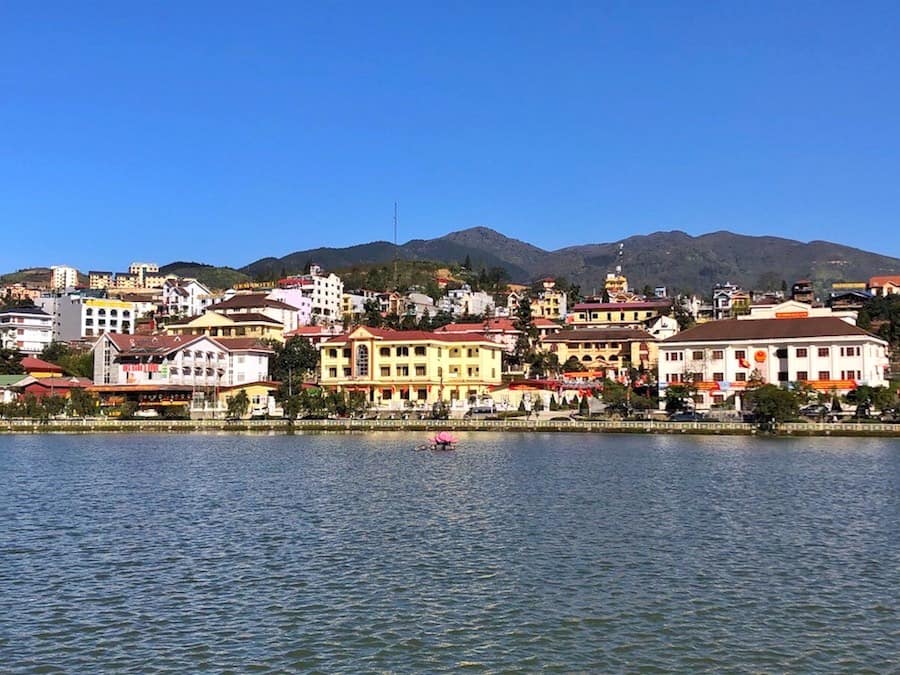
Most travellers visit Sapa for the trekking but this small town also deserves to be explored. You could easily spend a day or two just wondering around Sapa and it’s surroundings. Here’s a quick list of things to do in Sapa besides trekking
- Rent a motorbike and head out to the Tram Ton Pass.
- Visit the ethnic hill tribe villages such as Cat Cat Village.
- Hike up to Fansipan Peak.
- Shop for souvenirs at the various markets.
- Visit the various waterfall that surround Sapa
- Take a cooking class.
The restaurants in Sapa are a bit pricier than what we were used to in Vietnam. The food quality was not bad but certainly not what Vietnamese food is famous for. There was one that I would recommend – a little restaurant, just off the main tourist strip, called Good Morning Vietnam (yeah, I know!)
So Which Sapa Trek Do I Recommend?
This is difficult to answer and it’s really a personal decision that’s up to you!

There are so many options that it will really be up to you and depend on your circumstances. How much time do you have? What is your budget? Do you prefer to travel independently? Do you want to spend time in Sapa town?
Some people prefer the comfort of having everything organised for them in Hanoi. Whichever trek you decide to book, you’re sure to have an amazing experience in this beautiful part of Vietnam.
When we did our trekking tour in Sapa we had so many questions. I hope that this guide has answered some of them and helped you decide which trek is for you. If you liked this post, or want to know anything else, please leave a comment. Thanks!



